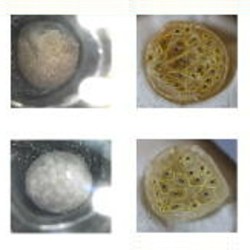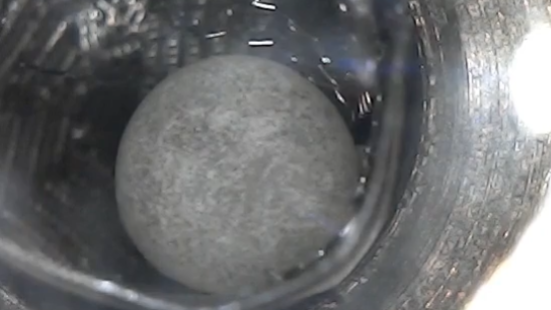This particular story on researchers successfully making yeast-free pizza dough has been making the rounds. As usual with stories written from a scientific angle, it’s worth digging into the details for some interesting bits. We took a look at the actual research paper and there are a few curious details worth sharing. Turns out that this isn’t the first method for yeast-free baking that has been developed, but it is the first method to combine leavening and baking together for a result on par with traditional bread-making processes.

Basically, a dough consisting of water, flour, and salt go into a hot autoclave (the header image shows a piece of dough as seen through the viewing window.) The autoclave pressurizes, forcing gasses into the dough in a process similar to carbonating beverages. Pressure is then released in a controlled fashion while the dough bakes and solidifies, and careful tuning of this process is what controls how the bread turns out.
With the right heat and pressure curve, researchers created a pizza whose crust was not only pleasing and tasty, but with a quality comparable to traditional methods.
How this idea came about is interesting in itself. One of the researchers developed a new method for thermosetting polyurethane, and realized that bread and polyurethane have something in common: they both require a foaming (proofing in the case of bread) and curing (baking in the case of bread) process. Performing the two processes concurrently with the correct balance yields the best product: optimized thermal insulation in the case of polyurethane, and a tasty and texturally-pleasing result in the case of pizza dough. After that, it was just a matter of experimentation to find the right balance.
The pressures (up to 6 bar) and temperatures (145° Celsius) involved are even pretty mild, relatively speaking, which could bode well for home-based pizza experimenters.
















Sorry, but you obviously don’t understand what makes bread so good.. or what makes a “good bread”. Yes.. you can puff up dough in ways other than yeast farts.. but you’re missing an almost more important, secondary impact that yeast has on the classic bread favors and aromas. Not only will a bread without live microbial leavening have a “flat” doughy flavor profile.. but you won’t get the complex sugars and starch breakdowns into all those classic flavors and smells that make up a great bread. Not to mention the pre-digestion benefits of the starches and gluten being broken down for you. If you just want to puff it up, you can do the same with baking powder.. essentially getting you a “puffy unsalted cracker”. oh boy.. yum.
Bread yeast makes some incredibly good eats.. hot out of the oven that people salivate over. My family has never fought over crackers.. Not to mention the complexities of a super complex sour dough fermented over night! Fuhgetaboutit!
Plus, I don’t need a lab and autoclave. If I want a puffy cracker.. I’ll buy some pit bread.
I think someone got a research grant.. ;)
Maybe this will be commercialized as a continuous process extruding out infinite pizza roll. Flavors can be replaced with artificial additives, and the time saved from leavening will improve profit margins by at least 0.1%!
+1
Maybe this could be the basis of 3D printed bread!
The extra proteins and amino acids from yeast would be nice to have though – not just starch and gluten.
As somebody who once had to cut yeast based stuff out of my diet for a while (some hard to pin down health problem, tried removing all occasionally problematic diet bits one at a time) being able to get a good bread like texture is also a real challenge, you can get things to rise with baking power but it doesn’t work out the same way, even with other additives to make it closer.
Obviously won’t get all the complex yeast derived flavours, which IMO is a real shame, but then you don’t get them in a huge number of commercial breads anyway being so bleached and plasticy as to be devoid of flavour by design…
Unfortunately a post of mine regarding the healt benefits of long leavening periods got stuck in the spam filter or something.
It’s not the yeast or gluten (for MOST of the people) which makes them sick. It’s that the “bad” stuff which is part of the wheats defense mechanisms isn’t consumed by the bacteria if leavening times are in the minutes range, not hours or days like it used to be…
You forgot to mention the health benefits of leavened doughs. Yeast (and all the amazing “critters” in sourdough) make the bread digestable for us humans. All the gluten-free stuff that is around today (which is a multi billion dollar business anyway) came to be because leavening times got cut down to minutes! instead of many many hours in industrial baking.
You give the dough time to rise and the microbes time to digest the “bad” stuff and it makes for a perfectly healthy food. There’s no shortcut to it. Manybe some day, but now now. The longer you let the microbes do their work, the better the product will be.
Making bread with 40g of yeast per 500g of flour makes as bad a product as using no yeast at all and try to “puff it up” physically…
Near-perfect appeal to nature fallacy:
“Health benefits” but not actually mentioning them
Mentioning lots of money made by *gasp* corporations
Claiming something new is “bad” in some nebulous, unmeasurable way, while mentioning the old way is “better”.
Go to your scientific paper outlet of your choice and read up on FODMAPS, sourdough and it’s effects on digestibility of starches, fermentation times, …
I’m not talking homeopathy here. It’s science.
Throw in a catchy abbreviation that hides the complexity of your claim!
FODMAPS are actually beneficial for normal gut biota, and avoiding them entirely is considered detrimental. They’re only a problem where you have issues absorbing particular ones, such as lactose. I doubt you’ll find things like isomalt, maltitol, mannitol, sorbitol and xylitol in your flour unless it was deliberately added.
>”A 2019 review concluded that wheat fructans can cause certain IBS-like symptoms, such as bloating, but they are not likely to cause immune activation nor extra-digestive symptoms since, in fact, many people with non-celiac gluten sensitivity report resolution of their symptoms after removing gluten-containing cereals while they continue to eat fruits and vegetables with high FODMAPs content in their diet.”
FODMAPS may be science, but you’re talking crank. Apparently the spam filter system recognizes it too, since it’s holding back any comments about it.
Part of the initial impetus was Di Maio has a yeast allergy, apparently.
Yes, it will not taste the same a yeast-leavened dough. If that bothers you, don’t eat it.
I agree I prefer yeast, but the texture of soda bread doesn’t work for pizza. Don’t know if this is better?
Took me a long while to get it right but you can get a nicely aerated bread with a decent texture using some baking soda and a bottle of fizzy water (7up works but it’s too sweet). Sure you don’t build up the gluten through kneeding but it’s still fairly decent. Par-bake it so it’s solid enough to support the toppings and you’re good. That was when my partner at the time had a yeast intolerance. Now it’s all yeasty, kneeded and prooved (and the occasional soda) breads.
Well this is a stupid hot take. The guy that developed this technique did so because he became allergic to yeast.
If you’re allergies are yeast caused, does that mean you live in a sterile filtered environment? Afaik, the wee beasties are omnipresent
All sorts of degrees to allergy – folks with hayfever are a common and obvious case in point, often bothered by only one type of pollen and only bothered when it really gets high concentrations, though some folks are set off by almost everything at low concentrations, but its never really gone from the air…
So yeast concentrated and deliberately grown for culinary purposes is going to be rather worse dosage wise I would think than the bits floating around.
Absolutely! However intolerances tend to be gut related (and so need to be consumed). They tend to be overlooked when compared to allergies (anaphylaxis is life threatening after all) but living with two family members with serious intolerances I wouldn’t wish it on anyone. I’ve had cryptosporidium and e.coli poisoning and an accidental tablespoon of butter cream was worse (internal bleeding worse).
Isn’t a large part of the aromas of bread due to the heat-caused chemical reactions ? The problem of the baking powder is that it can leave a metallic taste. Even if I too can’t see the point of making a pizza free of something we can make an infinity of, bread isn’t only good bread because of the yeast but also because of the baking.
OK, I will say it. The top right photo looks like a very good crumpet.
I was thinking it!
6 bar and 145° Celsius compared to 1 bar and 30° Celsius. I think the yeast must have figured out cold fusion.
If “cold fusion” is your nickname for a chemical reaction (combustion). Taking a solid hydrocarbon and burning it to H2O and CO2, creates lots of heat and gas pressure.
enzymes are part science, part magic
I don’t agree that those temperatures and pressures would be very comfy for my living room.
Every manufactured bread product I’ve ever eaten raises my blood sugar as if I’ve eaten a candy bar. Naturally leavened breads are totally fine. Just because it’s fast and consistent doesn’t make it good for consumption.
Here in the UK, I once bought a used US bread machine. I was shocked to find the recipe called for 3 tablespoons of sugar per loaf (and it didn’t rise properly if I used less).
A UK-aimed (Panasonic) machine I subsequently bought used 1 tablespoon for most programmes.
But it also has a fairly well-hidden “French bread” programme that does two kneed/rise cycles (6 hours) and that doesn’t need any added sugar at all, and rises just as well. Guess which I use!
Yeah I’ve seen the same thing – though the breadmaker we have came with recipes that are not as bad even as the Panasonic, again its UK aimed machine and 1 tablespoon was the largest amount of sugar in any bread recipe but the sweetbreads, which naturally would either have lots more refined sugar or some sweet plant syrup/honey…
Not that I stuck to the recipes at all anyway.
So they give the dough “the bends”?
Take it all the way and char the wheat foam into carbon foam then heat to about 900 celcius under nitrogen to make it glassy carbon foam. As for using the idea to make food, no thanks I prefer natural sourdough bread is full of vitamin and reduced in sugars and carbohydrates.
Now I’m wondering what microbes could be used to foam polyurethane.